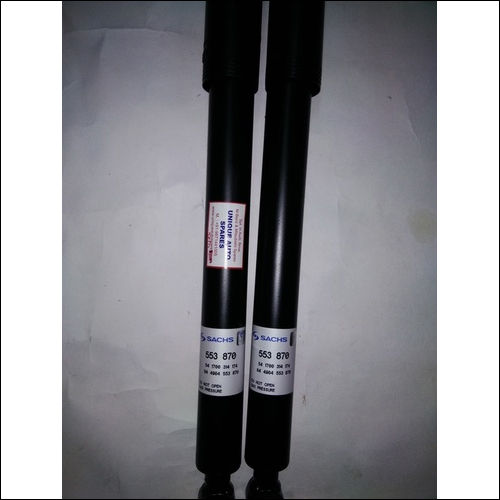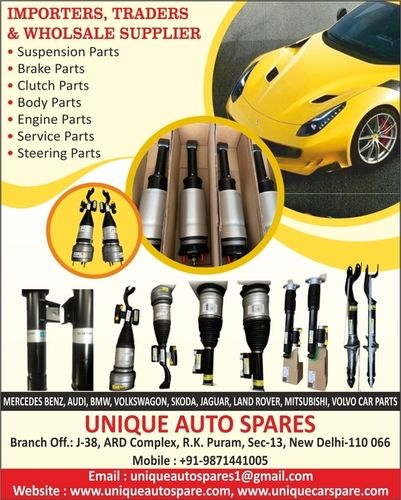BMW Suspension Parts
Product Details:
- Product Type BMW Suspension Parts
- Click to View more
BMW Suspension Parts Price And Quantity
- 1 Box
BMW Suspension Parts Product Specifications
- BMW Suspension Parts
BMW Suspension Parts Trade Information
- 1000 Box Per Day
- 1 Days
- cardboard box and cover with sack
- All India
Product Description
A car shock absorber, also known simply as a "shock," is an integral part of a vehicle's suspension system. It helps to control the movement of the vehicle's springs and suspension, thereby ensuring a smoother ride, improved handling, and better overall vehicle stability. Hereïs an in-depth look at car shock absorbers:
Purpose and Function of Shock Absorbers
-
Damping Oscillations:
- Shock absorbers dampen the oscillations of the springs, preventing excessive bouncing after hitting bumps or potholes.
-
Improving Ride Comfort:
- By absorbing and dissipating energy from road impacts, shock absorbers provide a smoother ride.
-
Enhancing Handling and Stability:
- They keep the tires in contact with the road, which is crucial for steering, braking, and overall vehicle control.
-
Reducing Wear on Other Components:
- By controlling the movement of the suspension, shock absorbers help reduce wear on tires, brakes, and other suspension components.
Types of Shock Absorbers
-
Hydraulic (Oil) Shock Absorbers:
- Use hydraulic fluid to dampen the motion of the springs.
- The fluid is forced through small orifices inside the shock absorber, creating resistance to the springïs motion.
-
Gas-Charged Shock Absorbers:
- Similar to hydraulic shocks but with nitrogen gas added to reduce the aeration and foaming of the hydraulic fluid.
- Provide better performance and consistency, especially under hard driving conditions.
-
Coilover Shock Absorbers:
- Combine a coil spring and shock absorber into a single unit.
- Common in performance and racing applications due to their adjustability and compact design.
-
Adjustable Shock Absorbers:
- Allow the damping characteristics to be adjusted manually or electronically.
- Found in high-performance and luxury vehicles, allowing for changes in ride comfort and handling characteristics.
Components of a Shock Absorber
-
Piston and Piston Rod:
- The piston moves up and down within the shock absorberïs cylinder.
- The piston rod connects the piston to the suspension system.
-
Cylinder (Tube):
- Contains the hydraulic fluid or gas and houses the piston.
- Typically has two chambers: a compression chamber and a rebound chamber.
-
Valves:
- Control the flow of fluid between the chambers.
- Create the damping effect by restricting fluid flow, thereby controlling the movement of the piston.
-
Mounting Points:
- Connect the shock absorber to the vehicleïs frame and suspension components.
- Include rubber bushings to reduce noise and vibrations.
Symptoms of Worn or Failing Shock Absorbers
- Excessive Bouncing:
- The vehicle continues to bounce after hitting a bump or pothole.
- Poor Handling:
- Reduced stability, increased body roll, or a "looseï feeling while driving.
- Uneven Tire Wear:
- Abnormal wear patterns on the tires due to inconsistent contact with the road.
- Leaking Fluid:
- Visible hydraulic fluid leaking from the shock absorber.
- Nose Dive or Squat:
- The front of the vehicle dips excessively during braking, or the rear squats during acceleration.
- Clunking or Rattling Noises:
- Unusual noises from the suspension area, indicating loose or damaged components.
Replacement and Maintenance
-
Regular Inspections:
- Check for signs of wear, leakage, or damage.
- Inspect at least every 50,000 miles or as recommended by the vehicle manufacturer.
-
Replacement Procedure:
-
Tools and Materials Needed:
- Jack and jack stands
- Socket set and wrenches
- Torque wrench
- New shock absorbers
-
Procedure:
- Lift the Vehicle: Safely lift the vehicle using a jack and secure it with jack stands.
- Remove the Wheel: Take off the wheel to access the shock absorber.
- Disconnect the Shock Absorber: Remove the bolts and nuts securing the shock absorber to the suspension and chassis.
- Remove the Old Shock Absorber: Carefully take out the old shock absorber.
- Install the New Shock Absorber: Place the new shock absorber in position and secure it with bolts and nuts. Use a torque wrench to tighten to the manufacturerïs specifications.
- Reassemble and Test: Reinstall the wheel, lower the vehicle, and test the suspension for proper operation.
-
-
Professional Alignment:
- After replacing shock absorbers, itïs advisable to have the vehicleïs alignment checked and adjusted to ensure proper handling and tire wear.
















